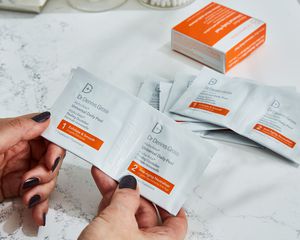
Getty
Every dog has its day, and every so often, TikTok trends are simply a miss. Don't get me wrong—I've been influenced by the app to try some gimmicky products and outlandish routines in hopes of enhancing my daily rituals (like this weird mopping hack I invested my time and money into—it works, JSYK). Of course, when the new "dry cleansing" hack popped up in my FYP, I had to give it a whirl. Unfortunately, it turned my skin beet red, which is when I put my detective cap on to see if I was doing it wrong or if the entire trend is just a hoax.
Ahead, everything you need to know about TikTok's dry cleansing trend.
What Is Dry Cleansing?
"Dry cleansing is a method where water is not used on the skin when washing," says the Director of Cosmetic & Clinical Research in Dermatology at Mount Sinai Hospital and Medical Director of JORI, Joshua Zeichner, MD, FAAD. TikTok users are singing the praises of a cleansing routine that involves using dry hands to rub their cleanser onto dry skin. While rubbing, the cleanser turns into a white film reminiscent of a face mask—after that, they wash the cleanser off with water and follow with the rest of their routine.
If you're asking why?, it's because TikTokers are claiming that this cleansing routine helps them to clear their pores and minimize sebum production, while its undiluted nature helps cause a significant uptick in the concentration of active ingredients.
Does Dry Cleansing Work?
The answer to the million-dollar question of whether this technique is effective or not is an underwhelming "yes" and "no." I know, harumph—but dry cleansing's efficacy depends entirely on the cleanser you use.
"Foaming and gel cleansers should not be used without water," Dr. Zeichner reveals to Byrdie. "They are designed to be used in small amounts with water. Using large amounts, undiluted, can lead to irritation and dryness with disruption of the skin barrier. This also does not work with bar soap." (This explains my red and irritated complexion, as I tried dry cleansing with a foaming cleanser.) Daniel Isaacs, Director of Research at Medik8, says that due to their formulation, most cleansers actually work better when activated with water (shocker, I know). "In general, applying cleansers to damp skin can help to quickly activate the cleansing agents within the formula, and can increase the penetration of the active ingredients into the skin, as damp skin is more permeable."
On the other hand, there are ways to use dry cleansing for clearer pores without wreaking havoc on your complexion. "The way I can approach this trend as a holistic esthetician is with an oil cleanser," says Amity Murray, Holistic Esthetician practicing at Nest Wellness in NYC. "Oil cleansers are meant to be applied to dry skin. The oil acts like a vacuum to the oil in your skin, deeply cleansing without disrupting the barrier layer of your skin or over-stripping."
Dr. Zeichner mentions that you can also use cleansing lotions, creams, balms, and oils, as well as micellar water, for a water-free cleanse. He adds, "Lipid-free cleansers, like the original Cetaphil, can be applied to the skin, rubbed into the areas that need cleansing, and then wiped off without water. They are designed to leave behind a hydrating film."
Is Dry Cleansing Safe?
Other than using the right type of cleanser, a dry cleansing routine's safety depends on the active ingredients inside your cleanser. Says Jaimie DeRosa, MD, Double Board-Certified Facial Plastic Surgeon and Founder and Lead Facial Plastic Surgeon of DeRosa Center Plastic Surgery & Med Spa in Boston and Palm Beach, "Generally speaking, a higher concentration of an active ingredient will deliver more medication to the skin's surface. With that in mind, this may not necessarily be beneficial as higher concentration of medications means higher doses that may result into development of negative side effects."
Dr. DeRosa explains that people with sensitive skin or certain inflammatory conditions such as eczema and seborrheic dermatitis may experience an exacerbation of the inflammatory process, which can lead to severe irritation. She advises, "The substances that I would absolutely NOT recommend rubbing into the skin undiluted are alcohol, certain fragrances, astringents, acids (salicylic and glycolic especially), as well as benzoyl peroxide."
If you are looking to dip into the routine, regardless, Dr. DeRosa recommends looking for moisturizing cleansers that contain hyaluronic acid, ceramides, or plant-derived oils.
The Bottom Line
If you're looking for a deeper clean from dry cleansing, it is possible—just be informed about the cleanser types that you're using and use a formula that will suit your skin's sensitivity levels. Per the expert's recommendations, do not use this technique with bar, gel, or foaming cleansers. Instead, opt for a cleanser meant to be rubbed onto dry skin, like a cleansing oil, balm, cream, or lotion; a lipid-free cleanser; or micellar water. If you have especially sensitive skin, use a cleanser containing hyaluronic acid or ceramides to replenish your moisture barrier. And regardless if you have sensitive skin or have never seen a speck of redness on your face, stay away from ingredients like alcohol, acids, and benzoyl peroxide. If clearing out the pores and minimizing sebum production are at the top of your skin care goals, opt for a serum or essence that contains chemical exfoliants that you can use after cleansing instead.
















